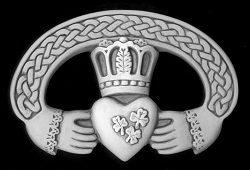Looking for Irish protection symbols? Want to know about all the different styles of protection symbols available? Read our guide for more information on choosing the right symbol for you…
Symbols for protection abound in the ancient Irish pre-Christian pantheon. The Celtic people of Ireland placed a high emphasis on nature in their spiritual worship who developed representations derived from the natural world as symbols of protection. Primary among the ancient Irish protection symbols was the Celtic knot.
The Celtic people were expert metal workers and the Celtic knot featured prominently in their designs. These Irish protection symbols consisted of an unending arrangement of interlacing knots with a stylized design. The ancient Celts emblazoned the knot on the shields of their warriors to protect them against the ravages of war and the weapons of their enemies. This protection symbol was woven into the clothing of children to shield them against pestilence and the malicious ministrations of other worldly beings. The never-ending circle of the knot safeguarded the sick in amulets and blankets.
As part of the Irish protection symbols, the Celtic knot was illustrated in the Book of Durrow. This book is included in the 7th century illuminated Gospel Book of Celtic Art, beautifully illustrated by early Christian monks. The Insular art of the monastic discipline is singularly spectacular in its painstaking attention to detail and exquisite creativity.
The Celtic Cross is another of the Irish protection symbols which originally had equidistant arms within a circle that signified the cycle of life. With the advent of Christianity, the Celtic Cross was appropriated as a symbol of the Christian faith. The arms of the symbol were lengthened to reflect the iconography of the Church.
Patterns in Irish Protection Symbols
The knot work of Irish protection symbols is composed of interlacing knots that reflect how human life and the universe are interconnected. As this symbol derived from the pre-Christian era, the ancient Celtic people used the knot to explain how human beings depended on nature for their continued survival and prosperity. A later version of the knot was the Trinity, which attempted to represent and explain the characteristics of the Holy Trinity.
The Celtic knot was the most admired of the Irish protection symbols that found most favor among the ancient Celtic people. It was used on the shields of warriors to protect them in war. The knot was also woven on the clothing of children and the blankets of the sick.





